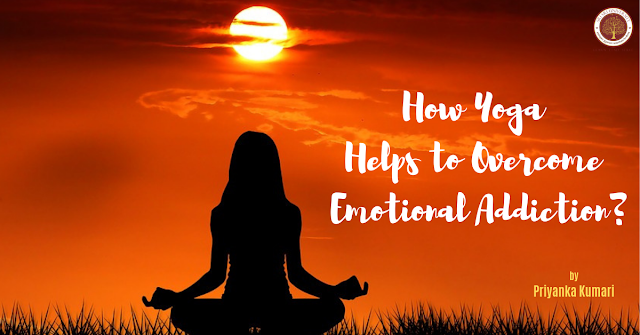RECENT BLOG ARTICLES
Yoga
How Yoga Helps to Overcome Emotional Addiction?
May 11, 2019
By : Ms. Priyanka Kumari – Student, 2nd Yr M.A. Yogic Science

Yoga is about practicing love, kindness, compassion, and correct ways to reach enlightenment.
We experience various emotions, both positive and negative. We often, however, welcome happiness, love and peace and resist emotions such as fear, anxiety and grief. It may be noted, when our prana is low due to stress or overwork, we tend to feel sluggish. In extreme situations, we turn to psychotherapy, medication to get rid of the negative emotions. Practicing yoga with attention helps increase the prana or energy levels, improves alertness and also calms the body. Yoga offers practical tools to ease our emotional issues.
People, often hold back emotions and are not expressive. These unexpressed emotions, over time, create physical tightness, stress, tension, and sometimes pain. Yoga is the perfect tool to release emotional tension and helps in healing. There are many tools in Yoga such as asana, pranayama, pratyahara, meditation and chanting’s that helps release the stress that remains accumulated over the years.
One of the most ancient Yoga techniques Pratyahara helps overcome emotional issues rooted in the sensations of the breath and the body. Through this technique, the focus is turned inwards and one can feel things that lie under the surface of ordinary awareness. It helps dissociate an individual’s awareness from the external inputs that are responsible for the emotions. One is required to keep the mind focused on where one feels and experiences sensations. Thereafter, one is required to explore the physical sensations start and pay attention to any emotional feelings that arise from these physical sensations. Yoga nidra helps release uncomfortable emotions. When emotional feelings emerge, one must keep the focus on the sensation of the feeling and not the mind’s thoughts, reactions or memories. In this way, Pratyahara helps overcome emotional issues.
Pranayama is yogic breathing which helps release emotions through the breath. There are several breathing techniques that can encourage emotions to be stimulated, brought to the surface, and released. Kapalabhati strongly stimulates and moves emotions that lie near the surface of the body, bringing them up and out. Breathing through the mouth invokes the emotional body and is highly effective in expressing and releasing emotions that have been brought to the surface, especially sadness and grief. Haaa breathing (exhaling with a “Haaa” out of the mouth) helps release anger and frustration.
Mantra chanting opens the throat (vishudhi) chakra and helps in the release of tension and emotions from the body. When an individual is at a heightened state of emotions, mantra chanting is extremely effective. It helps release the hidden emotions from the body and mind.
Meditation helps in clearing repressed memories which remain hidden because of deep, painful emotions. Meditation makes this easier, by allowing one to be in a neutral emotional state (witness state) to face the unconscious mind. Many people tend to respond to life’s inputs with the same old set of emotions, over and over again. Some people respond with anger, some with hurt feelings, some with guilt, some with humor, all to the same situation! Meditation allows one to “see” the root cause of these emotions. It also develops the ability to witness the situation and responses and make better choices. In addition, it expands awareness, so that one is able to see the “bigger picture” of life and respond accordingly.
When one understands one’s feelings, and why one is overwhelmed by specific emotions, he has the power to alter the power within. Yoga teaches people to separate themselves from their negative feelings and reduces emotion-based decisions, and even when a negative emotion is felt, it does not affect the true person’s self.
Facebook
LinkedIn
Twitter
Print







